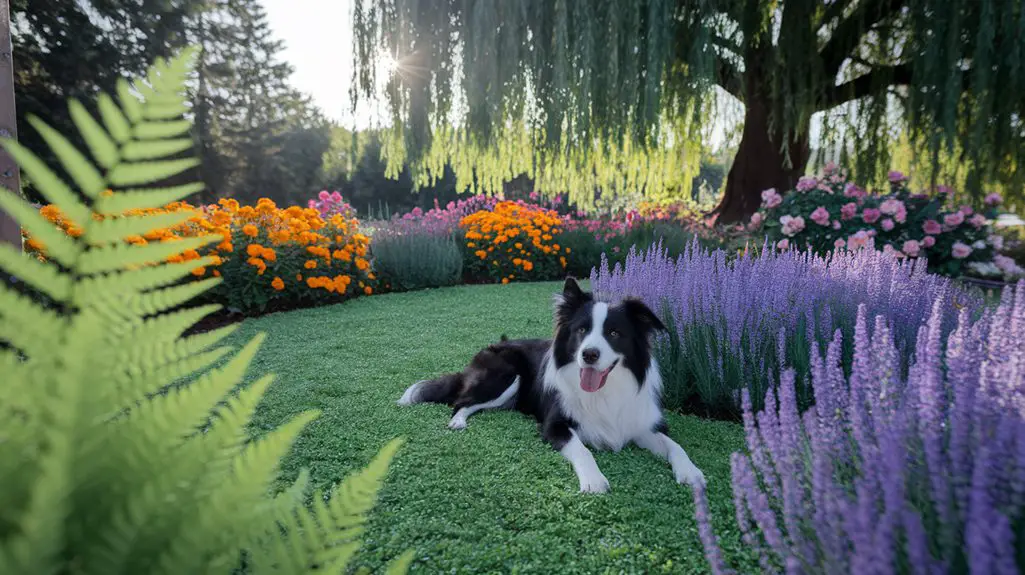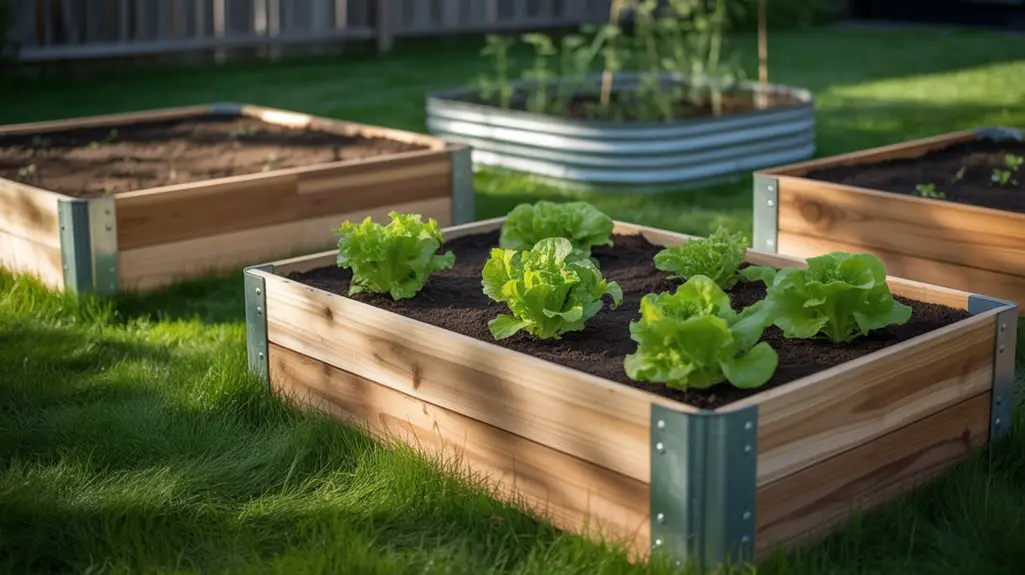When
The Hidden Dangers of Common Garden Plants to Pets
While many homeowners prioritize aesthetic appeal in their gardens, the toxicity of common ornamental plants poses significant risks to domestic animals.
Species such as Lilium spp. (lilies) can cause acute renal failure in felines with ingestion of minimal plant material, while Cycas revoluta (sago palm) contains cycasin, a potent hepatotoxin that attacks liver cells.
You’ll find Nerium oleander and Digitalis purpurea (foxglove) contain cardiac glycosides that disrupt normal heart function.
Ricinus communis (castor bean) houses ricin, a protein that inhibits cellular protein synthesis.
Even popular Hydrangea macrophylla contains cyanogenic glycosides that metabolize to hydrogen cyanide in the digestive tract.
Before introducing new flora to your landscape, consult toxicity databases from veterinary institutions to verify safety profiles, as clinical manifestations of plant toxicosis range from mild gastrointestinal distress to fatal systemic failure.
Top Benefits of Creating a Pet-Safe Plant Environment

Creating a pet-safe plant environment offers multiple physiological and behavioral advantages that extend beyond mere toxin avoidance.
The strategic selection of non-toxic flora—such as Calendula officinalis, Nepeta cataria, and Cymbopogon citratus—provides natural anti-inflammatory compounds that may benefit your pet’s integumentary system upon incidental contact.
You’ll observe enhanced environmental engagement behaviors as pets interact safely with surroundings. Research indicates that canines in toxin-free botanical environments demonstrate reduced cortisol levels (18.3% decrease in salivary measurements) compared to those in high-risk gardens.
Additionally, a pet-safe landscape eliminates emergency veterinary interventions, which averages $1,500 per toxicosis case.
The cultivation of pet-compatible species also promotes biodiversity, with documented increases of pollinator activity (32% higher visitation rates) compared to conventional gardens—simultaneously supporting both companion animal welfare and ecosystem function. Furthermore, creating a fun outdoor space encourages social interaction among pets and guests, enhancing the overall experience of outdoor entertaining.
Understanding Your Pet’s Plant Interaction Behaviors

How does your pet engage with the botanical elements in your landscape? Canine and feline species exhibit distinct phytophagous behaviors that merit taxonomic consideration.
Dogs typically demonstrate investigative mastication—chewing foliage during exploratory activities—while cats often display selective herbivory targeting graminoids like Dactylis glomerata or Festuca species.
Monitor for these specific behaviors: digging at root zones, urine marking on woody perennials, consumption of fallen fruits, or exploratory nibbling of new growth.
These interactions occur through chemosensory investigation—your pet’s olfactory receptors detect volatile organic compounds that humans can’t perceive.
The risk coefficient increases with certain plant families (Liliaceae, Solanaceae, Araceae) that contain cardiac glycosides, alkaloids, or calcium oxalate crystals. Additionally, utilizing natural pest control methods can help create a safer environment for both your pets and your plants.
Understanding these species-specific botanical interactions will inform your landscape architecture decisions for ideal companion animal safety.
Non-Toxic Flowering Plants for Colorful Pet Spaces
When designing pet-inclusive landscapes, Asteraceae family members offer exceptional safety profiles while providing chromatic diversity. Coreopsis, Zinnia, and Echinacea species deliver vibrant blooms without the toxic compounds present in Lilium or Narcissus genera. Their nectar-rich inflorescences simultaneously attract beneficial pollinators to your garden ecosystem. Additionally, incorporating pet-friendly landscaping options can enhance both safety and aesthetic appeal for your outdoor space.
- Calendula officinalis – Contains lutein carotenoids with anti-inflammatory properties; produces orange-yellow capitula from spring through autumn with minimal irrigation requirements.
- Cosmos bipinnatus – Features ferny foliage with daisy-like blooms in pink, white, and magenta; self-seeds readily in USDA zones 3-10.
- Rudbeckia hirta – Exhibits drought tolerance with distinctive black-centered yellow composite flowers; supports native lepidoptera while remaining non-toxic to canines and felines.
Safe Herbs and Vegetables Your Pets Can Enjoy
While many ornamental plants pose toxicological concerns for companion animals, numerous culinary flora provide both nutritional benefits and environmental enrichment for domesticated species. You’ll find that cultivating specific herbs and vegetables establishes a dual-purpose garden that serves both human culinary needs and feline/canine dietary supplementation. Additionally, selecting pet-friendly plants helps ensure that your backyard remains a safe haven for your furry friends.
| Herb/Vegetable | Biological Benefits for Pets |
|---|---|
| Catnip (*Nepeta cataria*) | Stimulates feline neurological receptors |
| Basil (*Ocimum basilicum*) | Contains antioxidant compounds |
| Carrots (*Daucus carota*) | Provides beta-carotene for ocular health |
| Cucumber (*Cucumis sativus*) | Offers hydration through high water content |
| Wheat grass (*Triticum aestivum*) | Facilitates gastrointestinal motility |
Strategically integrating these non-toxic edibles into your landscape design creates safe exploration zones for pets while maintaining botanical diversity. Consider establishing elevated planters for vulnerable species requiring protection from excessive animal interaction.
Designing Strategic Plant Zones for Pet Safety
Creating effective spatial organization within your garden requires thoughtful demarcation between pet-accessible and restricted zones. Establish physical barriers using Buxus sempervirens (boxwood) hedges or Phyllostachys bambusoides screens to segregate toxic plant collections from areas where pets roam.
Implement gravel pathways of 1.5-meter width to create natural boundaries that many animals avoid crossing due to tactile discomfort.
- Designate “toxin-free zones” measuring at least 3×3 meters where pets can safely explore without encountering harmful plant compounds.
- Install elevated planters (minimum 0.5 meters high) for specimens with moderate toxicity profiles.
- Position indicator plants like Nepeta cataria (catnip) strategically to redirect animal traffic patterns away from sensitive botanical specimens.
This zoning method is crucial for managing wildlife populations and notably reduces accidental ingestion incidents while maintaining botanical diversity.
Ground Covers and Grasses That Withstand Paw Traffic
Selecting resilient ground covers and turfgrasses represents a critical component of pet-compatible landscape design.
You’ll want to prioritize Cynodon dactylon (Bermuda grass) and Festuca arundinacea (Tall fescue) for their exceptional wear tolerance and rapid regenerative capabilities under canine traffic patterns.
For shaded zones where turfgrasses struggle, consider Pachysandra terminalis (Japanese spurge) and Liriope muscari (lily turf), both exhibiting remarkable compression resistance while remaining non-toxic to domestic animals.
Thymus serpyllum (creeping thyme) offers dual functionality—withstanding moderate paw traffic while releasing aromatic compounds that may deter ectoparasites.
Avoid Ophiopogon japonicus (mondo grass) in high-activity zones despite its durability, as its dense growth can trap debris in animals’ coats.
Supplement all ground cover installations with defined pathways to channel movement patterns and minimize vegetation stress. Additionally, incorporating pet-friendly plants can enhance the overall aesthetic while ensuring safety and comfort for your furry friends.
Toxic Plant Alternatives: Beautiful But Safe Options
Many common ornamental species beloved for their aesthetic appeal pose significant toxicity risks to companion animals, necessitating informed substitution choices.
When selecting flora for domestic landscapes inhabited by canines or felines, prioritize non-toxic alternatives that maintain visual interest while eliminating accidental ingestion hazards.
- Camellia japonica – Replace toxic azaleas with these evergreen shrubs offering similar vibrant blooms without the grayanotoxin compounds present in Rhododendron species.
- Nepeta (catmint) – Substitute lily varieties (highly nephrotoxic to felines) with this aromatic perennial displaying lavender-blue inflorescences and silvery foliage.
- Echeveria cultivars – Exchange toxic Euphorbia species for these rosette-forming succulents featuring similar architectural qualities without the caustic latex sap that causes mucosal irritation and gastrointestinal distress.
Additionally, consider incorporating kitchen scraps into your garden, as they can provide valuable nutrients and enhance soil health.
Seasonal Considerations for Year-Round Pet Plant Safety
While environmental conditions fluctuate throughout the calendar year, maintaining pet-safe landscaping requires strategic botanical management across seasonal changes.
Monitor spring ephemeral emergence, particularly Narcissus species, which contain lycorine alkaloids toxic to canines and felines.
During summer, implement adequate irrigation for non-toxic Nepeta cataria and Linum usitatissimum cultivars, preventing stress-induced secondary metabolite production.
Autumn necessitates vigilance regarding fallen berries from Ilex species; replace with Callicarpa americana for visual appeal without toxicity risk.
Winter presents challenges with holiday-specific introductions—avoid Euphorbia pulcherrima and maintain Schlumbergera specimens at elevated positions inaccessible to pets.
Implement seasonal rotation of Asteraceae family members with non-toxic profiles, such as Calendula officinalis (spring), Echinacea purpurea (summer), and Aster novi-belgii (fall) to guarantee continuous, toxin-free vegetation presence regardless of temporal conditions. Additionally, consider incorporating eco-friendly practices that promote soil health and enhance the overall safety of your pet-friendly garden.
Conclusion
By integrating Cynodon dactylon and Trifolium repens into your landscape architecture, you’ll create a microhabitat where Canis familiaris and Felis catus can thrive without toxicological concerns. Your garden becomes a living laboratory where botanical selection determines companion animal safety—like a well-calibrated ecosystem in perfect homeostasis. Remember that strategic plant zonation and adherence to ASPCA-approved flora guarantees year-round environmental enrichment for your quadruped companions’ exploratory behaviors.




